#Egyptian Papyrus Painting
Explore tagged Tumblr posts
Text


I have a deep love of the King Papyrus ending. He is so very dear to me man and there's so much fanwork potential with it
This isn't the final design for how I plan on drawing King Papyrus, I just slapped him in Asgore's clothes because I didn't want to come up with an outfit I just wanted to draw him real bad :P
Don't even ask about what happened with Sans tho idk how my art took me in that direction. It just felt right. Also I adore the idea that Sans became the royal scientist when Papyrus became king
Also idk how bad Tumblr is going to butcher the quality so just click the images if they look like the ancient paintings on the walls of Egyptian pyramids
#undertale#sans undertale#papyrus undertale#undertale papyrus#undertale sans#king papyrus#neutral ending#my art
587 notes
·
View notes
Text

Ancient Egyptians created artificial plants. They crafted fake flowers and garlands from materials like painted linen, papyrus, and thin metals to decorate temples, tombs, and homes. This practice dates back to around 2500 BCE, making Egypt one of the earliest cultures to produce artificial plants.
Rines, George Edwin, ed. (1920). "Flowers, Artificial" . Encyclopedia Americana.
More dork content here
534 notes
·
View notes
Text
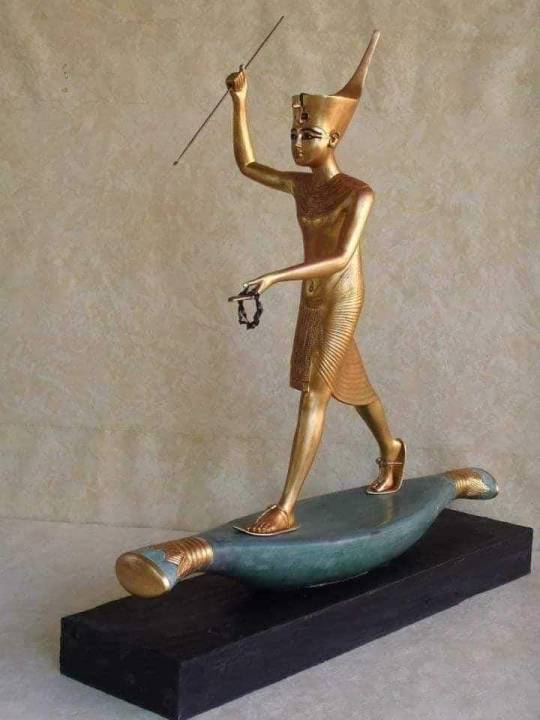
A small statue of Tutankhamun (1341-1323 BC), of gilded wood, depicting Pharoah wearing red crown of Lower Egypt, standing in a papyrus boat made of green painted wood, and gilded, where papyrus details are supposed to appear.
Egyptian Museum, Cairo
#tutankhamun#king tut#pharoah#egyptology#egyptian#ancient egypt#egypt#cairoegypt#cairo#toya's tales#toyastales#toyas tales#art#antiquities#egyptian archaeology#egyptian art#november#fall#Lower Egypt#papyrus#egyptian history#egyptian culture#egyptian king#egyptian pharaoh#world history#Gilded
235 notes
·
View notes
Text
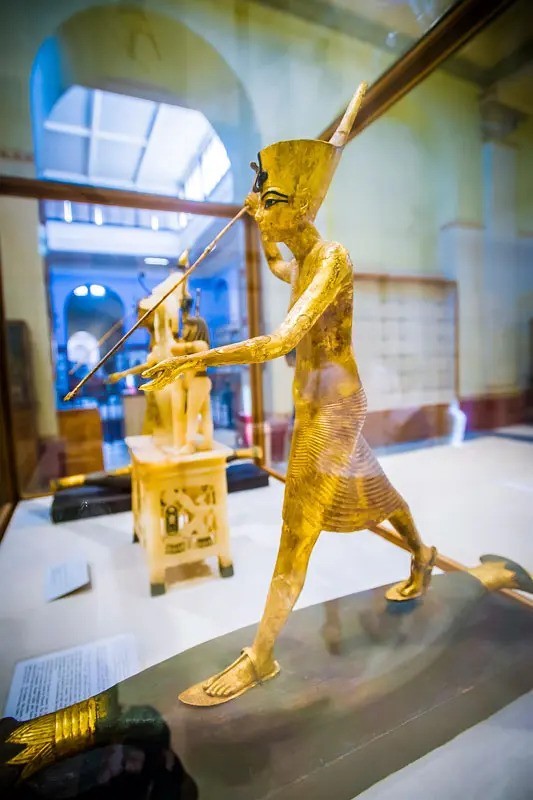
Statuette of Tutankhamun the Harpooner
Tomb of Tutankhamun (KV62), Valley of the Kings, Thebes. Now in the Egyptian Museum, Cairo. JE 60710
A gilded, wooden statuette of King Tutankhamun stands on a wooden boat that is painted to represent a papyrus boat. Its details are picked out in gold leaf. The king, wearing the Deshret Red Crown of Lower Egypt, holds a harpoon poised to strike an unseen enemy.
According to the myth of Osiris and Isis, the king here represents their son, Horus, who avenged his father, Osiris. His adversary, Seth, often portrayed as a hippopotamus or crocodile, is not depicted, as he is a potentially harmful image. The figure of the king holds a bronze coiled chain to bind the animal, representing Seth, after spearing it. The statue was found wrapped in linen in a varnish-blackened chest.
Read more
362 notes
·
View notes
Text
More Ancient Egyptian Art Vocabulary

for your next poem/story
Double crown - the crowns of Upper and Lower Egypt worn together
Dynasty - a series of rulers descending within a family; following the Ptolemaic historian Manetho, ancient Egyptian history is divided into thirty dynasties
Faience - a powdered quartz paste, which is modeled or molded and fired; it is either self-glazed or made with applied glaze
False door - a panel in the form of a niched doorway through which the deceased could receive offerings
Gesso - a mixture of whiting and glue often used to prepare a surface for painting
Harakhty - “Horus of the horizon,” the god of the rising sun, depicted as a falcon or a falcon-headed human crowned by a sun disk
Hathor - a goddess sometimes depicted as a cow or with cow’s horns and ears; associated with joy, music, and love
Heh - god of millions of years, of eternity
Hieratic - handwritten counterpart to the hieroglyphic script, developed in the Old Kingdom mainly for writing on papyrus; written from right to left
Hieroglyph - a Greek word meaning “sacred symbol.” In Egypt, one of some seven hundred signs used in writing (considerably more if one counts signs used exclusively in the Old Kingdom and the periods after the New Kingdom). “Hieroglyphs” refers to the signs themselves; “hieroglyphic script” is Egyptian writing. (Calling the signs “hieroglyphics” is incorrect.)
Horus - ancient sky god in the form of a falcon, embodiment of the divine powers of the living king; son of Osiris and Isis
Ideogram - (sense sign) a hieroglyph signifying the actual object depicted or a closely connected notion
Isis - wife of Osiris, mother of Horus, the divine magician because of her extraordinary powers, divine mourner of the dead; her name is written with the hieroglyphic sign for “throne,” which she wears on her headdress
Ka - life force; the hieroglyphic sign is a pair of extended arms
Maat - right order and justice established by the gods, personified by the goddess Maat, who wears an ostrich feather on her head or is represented by the ostrich feather itself
Magic rod - a squared or rectangular object carved with symbols, such as felines, crocodiles, protective wedjat eyes, and baboons tending lamps, that Egyptians may have believed helped the sun reappear each day from the chaos of night. These rods were placed in tombs to guarantee a similar rebirth to the deceased.
Mastaba - a type of Egyptian tomb having a rectangular superstructure with exterior walls slightly slanting inward as they rise; contains chapels, chambers, and a shaft leading to an underground burial
Mortuary temple - a temple erected and endowed by a king where he could receive offerings in perpetuity after his death
Mut - “mother”: worshiped as the consort of Amun; shown as a vulture or as a woman wearing the double crown
Myrrh - a fragrant aromatic plant gum used in making perfume, unguents, and incense
Source ⚜ More: Word Lists
#ancient egypt#art#terminology#word list#writeblr#writing inspiration#spilled ink#writing reference#dark academia#creative writing#light academia#literature#writers on tumblr#poets on tumblr#writing prompt#poetry#writing resources
106 notes
·
View notes
Photo

Ships of the Gods of Ancient Egypt
The Nile River was the source of life for the ancient Egyptians and so figured prominently in their religious beliefs. At night, the Milky Way was considered a heavenly Nile, associated with Hathor, and provider of all good things. The Nile was also linked to Uat-Ur, the Egyptian name for the Mediterranean Sea, which stretched out to unknown lands from the Delta and brought goods through trade with foreign ports.
Watercrafts were no doubt among the earliest conveyances built in Egypt, with small boats appearing in inscriptions in the Predynastic Period (c. 6000 - c. 3150 BCE). These boats were made of woven papyrus reeds but later were made of wood, grew larger, and became ships.
The ships of the Egyptians were used for commercial ventures like fishing, trade, and travel and also in warfare, but from at least the Old Kingdom of Egypt (c. 2613-2181 BCE), they also feature in religious beliefs and practices. Ships known as Barques of the Gods are associated with a number of different Egyptian deities and, although each had its own significance, their common importance was in linking the mortal world with the divine.
The Barque of Ra
Easily the most important divine vessel was the Barque of Ra which sailed across the sky each day as the sun. In one religious tale, Ra becomes enraged with humanity and their ceaseless stupidity and decides to destroy them by sending Sekhmet to devour them and crush their cities. He repents and stops her by sending her a vat of beer, which she drinks, passes out from, and wakes up later as Hathor, the friend to humans. In some versions, the story ends there, but in others, Ra is still not satisfied with humanity and so boards his great barge and sails away into the heavens. Still, since he cannot completely distance himself from the world, he appears each day watching over it as the sun. The solar barque the people saw during the day was called the Mandjet, and the one which navigated through the underworld was known as the Meseket.
By the time of the Middle Kingdom of Egypt (2040-1782 BCE), this myth included the added dimension of the Great Serpent known as Apophis. As the Barque of Ra descended into the west in the evening, it entered the underworld where Apophis waited to attack it. Apophis was present at the beginning of creation when, in one myth, Ra is the god who stands on the primordial mound and raises order out of chaos. Apophis wanted to return the universe to its original undifferentiated state and could do this if he destroyed the barge of the sun god and the sun god with it.
Other gods, as well as the souls of the justified dead, would travel on the barge with Ra to protect him and his ship from Apophis during its journey through the underworld. A number of paintings and inscriptions depict all of the most famous gods, at one time or another, fending off the Great Serpent either alone, in groups, or in the presence of the justified dead.
Mortals were encouraged to participate in this struggle from their homes and temples on earth. Rituals such as The Overthrowing of Apophis were observed in which figures and images of Apophis were made of wax and then ritually mutilated, spat on, urinated on, and burned. This was among the most widely practiced execration rituals in Egypt and linked the living with the souls of those who had passed on and with the gods.
Every night the gods, souls, and humanity joined together to battle chaos and darkness and preserve life and light, and each time they won, the sun rose in the morning, and the dawn light was an assurance that all was well with Ra and life on earth would continue. As the barge sailed across the sky, however, Apophis returned to life in the underworld and would be waiting again once night fell; and so the battle would have to be fought again.
Continue reading...
39 notes
·
View notes
Text
Direct Vision Spell for an Oracle 𓂀
A 2000 year old Greco-Egyptian magic spell

─── ⋆⋅☆⋅⋆ ──
[PGM V 54 – 69]
So sick of all these fake bs Tumblr and Pinterest spells-
"what color candle means what lol" with zero cultural or historical significance, it's like they just pulled things out of their ass.
So, here is a real 2000 year old Greek and Egyptian syncretic spell from Thebes to receive a direct vision from the beyond....WITH cultural and historical context.
Because, yes, history is important, and anyone giving you "spell tips" without telling you where the fuck they're from or what they mean is bullshitting you.
Ancient Greek oracular spells were rituals and invocations performed to gain insights or predictions from the gods, the Theoi, as well as Daemons and the Dead, particularly through seers known as oracles.
The Spell: PGM V 54 – 69 from the Greek Magical Papyri
Context of the Spell:
This spell is an interesting blend of Egyptian and Greek oracular practice: the use of Coptic or Egyptian eyepaint, kohl, here is interesting– as well as it's mixture with water from a sunken ship. Water from such locations are normally reserved for love spells, as we see previously in the PGM. The relationship or correspondence between a literal sunken vessel and sinking into the throes of passion. However, here, with its use in an oracular spell, it seems to correspond more to the chthonic or otherworldly realm, giving te wearer the ability to see past the normal, mundane world; past the ‘veil’ so to speak and into the beyond.
The use of the magical mystery word or voces magicae “Akrammachamarei” here is also notable; it is quite often seen throughout the PGM, and is associated with the God/Daemon/Archon of both Gnostic (Jewish-Egyptian) as well as Greek origin, Abrasax.
In spell PGM V. 96-172, Abrasax is identified as part of the "true name which has been transmitted to the prophets of Israel" of the "Headless One, (also known as the Egyptian god Bês) who created heaven and earth, who created night and day ... Osoronnophris whom none has ever seen ... awesome and invisible god with an empty spirit"; the name also includes Iaō and Adōnai, the ineffablenames of the Jewish god. "Osoronnophris" represents Egyptian Wsir Wn-nfr, or "Osiris the Perfect Being.” Another identification with Osiris is made in PGM VII. 643-51: "you are not wine, but the guts of Osiris, the guts of ... Ablanathanalba Akrammachamarei Eee, who has been stationed over necessity, Iakoub Ia Iaō Sabaōth Adōnai Abrasax."
Instructions:
─── ⋆⋅☆⋅⋆ ──
After you have purified yourself (through ritual bathing and declarations) you must put on your clean linen robes and sandals of Papyrus.
Then, taking a purified bronze censer, place the laurel leaves inside and light them until the smoke fills the room. Walk clockwise around the room, and your workspace, Chanting the Ephesia Grammata:
ΑΣΚΙ(ΟΝ) ΚΑΤΑΣΚΙ(ΟΝ) ΛΙΞ ΤΕΤΡΑΞ ΔΑΜΝΑΜΕΝΕΥΣ ΑΙΣΙΟΝ (or ΑΙΣΙΑ)
“askion kataskion lix tetrax damnameneus aision”
Then, taking the olive oil, pour it into the waiting bronze dish.
With your right hand, anoint your right eye with the prepared water from a shipwreck.
With your left hand, mix 1 part kohl with 1 part water until it is a viscous paint, from the same dish, and anoint your left eye so that it is completely surrounded by the paint.
Then, pronounce the incantations:
"EEIM TO EIM ALALĒP BARBARIATH / MENEBREIO ARBATHIAÔTH IOUĒL IAĒL OUĒNĒIIE MESOMMIAS,
let the god who prophesics to me come and let him not go away until I dismiss him,
OURNAOUR SOUL ZASOUL / OUGOT NOOUMBIAOU THABRAT BERIAOU ACHTHIRI MARAI ELPHEŌN TABAŌTH KIRASINA LAMPSOURĒ IABOE ABLAMATHANALBA AKRAMMACHAMAREI.”
Once the incantations are finished, present any offerings and ask over the prepared olive oil dish what your question(s) are. Stare into the oil, lit only by candle or oil lamp light, and you will receive a direct vision.
─── ⋆⋅𓂀⋅⋆ ──
For more information & how to pronounce the incantations, check here.
#chthonic sorcery#greek sorcery#sympathetic magic#ancient egypt#ancient history#ancient greece#greek magical papyri#pgm#coptic#Goêteia#oracle#visions#spellwork#spells#spell tips#witch tips#witchblr#witch community#Abrasax#gnosticism#anthropology#divination#divination spell#traditional witchcraft#Greco-Egyptian polytheism#oracles#greek oracle#prophesy#oracle of delphi#incantations
105 notes
·
View notes
Text
So! I originally was going to keep this more of a personal AU thing but someone asked so they shall receive ( @logbookqwerty )

Starring Chris Aleizam as Papyrus Comic for the upcoming movie "Under Tale"! Super original, I know.
BACKGROUND: Chris has played in a number of movies for about 8 years by now. Most of the time he played background characters, but his biggest hit role was "Papyrus Comic" which, luckily, he loves.
PERSONALITY: Very much like the original! Maybe a bit more overdramatic and flamboyant, but he mostly does it for the laughs. He isn't very interested in puzzles, but does arts as a hobby (painting, sculpting, drawing, etc)
RELATIONSHIPS: Vincent "Sans Comic" Kranio is one of his best friends since childhood. They are not brothers by blood but very much have a sibling dynamic they both play into. He has a celebrity crush on Bobby "Mettaton" Spark, which was only fueled by his fanboy role. Everyone else he is well acquainted with.
NOTE: They live in a world where humans and monsters have always co-existed, and in a world where Monsters can't really use magic (like in Deltarune)
Extra:
NAME LORE: Chris Costello was the designer of the Papyrus font, and the word "Aleizam" is Arabic for "Bones" (since the Papyrus font was supposed to mimic writing on Papyrus paper which the Egyptians used)
MULTIVERSE: He meets a scientist version of himself "Wings" through a freak accident of sorts and then meets "Comic", another Papyrus. A little peeved to find out that he's more of an outlier than the others. Also jealous that they can use magic while he cannot.
More to be added....maybe.......
#my art#undertale#ut#papyrus#papyrus undertale#undertale papyrus#undertale au#au#actor au#...should i give it a different name?#actor au454#.....good enough im tired anywho tee hee
32 notes
·
View notes
Text
Just me rambling about the husbands of Nephthys

The belief that Nephthys was the wife of Set largely comes from the writings of the Greek author Plutarch. Plutarch was a prolific writer and a priest at Delphi who likely obtained his information about Egypt during his travels to Alexandria. Although he accurately recounts much of Egyptian mythology, his writings are influenced by his philosophical views. By the time Plutarch wrote in the 2nd century CE, religious traditions had begun to merge, especially in Alexandria, where the cult of Isis was extremely popular.
Plutarch recounts a story in which Osiris unknowingly fathers a child with Nephthys, believing she was his wife, Isis. Nephthys, afraid of her husband Set's reaction, abandons the child, and Isis later finds and raises him as Anubis, who becomes her guardian. Interestingly, Plutarch also refers to a tradition where Nut’s children have different fathers: Horus and Osiris are Ra's sons, Isis is Thoth's daughter, and Nephthys and Set are the only children born in wedlock with Geb. Wikipedia states that Horus the Elder is a form of Horus that is the son of Geb and Nut, but this is only partly true: This claim comes from Plutarch, but Plutarch also claims that Horus the Elder is a son of Osiris and Isis, conceived by Isis and Osiris in the womb of Nut, and then born alongside the other children. Essentially, Plutarch tried to explain the multiple origin stories of Horus by stating that Osiris and Isis had supposedly three sons, all named Horus, and early Egyptologists somehow accepted this explanation. According to Plutarch, the three half-brothers also have different hair colors: Osiris has black hair, Horus white, and Set red. Additionally, Plutarch recalls a festival where Egyptians insulted red-haired people to mock Set's power on Earth. This has nothing to do with Nephthys’ marriages, but it's too amusing not to mention.
Overall, Plutarch paints a rather negative picture of Nephthys: Not only is she an adulterous wife who cheats on her husband, but she also has nonconsensual sex with Osiris, abandons her child in the desert, and even betrays Isis by revealing where she is hiding with her dead husband and child to Set. Plutarch also refers to Nephthys as Aphrodite throughout the text.
While many early sources link Nephthys and Set as a couple, there is little concrete evidence from ancient Egyptian texts directly confirming their marriage. Osiris, Nephthys, Set, Horus, and Isis are the core figures in the Osiris myth, and they all interact with one another inside th myths, except for Nephthys and Set. However, they are paired in other contexts, such as in descriptions of the Ennead. For example, in the Pyramid Texts, Nephthys and Set are paired together for specific roles, but they are not explicitly called a married couple. Some texts from later periods refer to Nephthys as Set’s wife, or mention Set having a wife, though these accounts are often times ambiguous and don't firmly establish this as a widespread early tradition. Therefore the tradition reported by Plutarch, in which Nephthys is the mother of Anubis by Osiris, finds little support in indigenous Egyptian sources, though it was likely not entirely invented by him.
As far as I can tell, we currently have no Ancient Egyptian texts that name Nephthys as Anubis’ mother, either by Set or Osiris. I know Wikipedia lists Anubis and Wepwawet as sons of Nephthys and Set, but no actual source is given for this information. Anubis is sometimes regarded as the son of Nephthys and Ra, though. The only real Egyptian source for Nephthys abandoning Anubis that I could find is in the Papyrus Jumilhac (“Nephthys, her bravery existed with him [Horus]. She had him [Horus] hidden as a small child in papyrus. His name is Anubis and his image is as Mehit-imyut.”). However, we should note that it is unclear whether Nephthys hid her son Horus-Anubis as Isis hid her child, or if she helps Isis hide the baby Horus-Anubis. In this text, Nephthys hiding her child is framed positively, not as the action of an adulterous woman abandoning her illegitimate child for selfish reasons.
Nephthys was sometimes regarded as Osiris’ wife in the underworld, just as Isis was on earth. Osiris and Nephthys are depicted as a couple in some contexts, as seen in the statue of Ramose from the Louvre (E 16378). Nephthys is sometimes given the title Onnophret, the feminine form of the Osirian epithet Onnophris or wn.nfr, meaning "the beautiful existent."
Interestingly, an erotic spell from the 4th century, mostly written in Greek with some Old Coptic passages, tells the story of how Isis goes to Thoth (specifically identified as her father in this version) and tells him about Osiris sleeping with Nephthys. Thoth then gives her a love spell to win Osiris back. However, it is unclear whether Isis is upset about Osiris taking a lover or a second wife. Alternatively, Nephthys could even be Osiris' first wife in this scenario, with Isis as the jealous sister.
There is one text I found that names Nephthys and Set as a married couple within the context of the Osiris myth. It's called the Ptolemaic Berlin Papyrus 8278, and it contains a story that goes as follows:
The first nine lines of Pap. Berlin P. 8278 are quite damaged. However, the main topic is the expulsion of Set from Egypt. The first readable paragraph tells how Set will be kept away from Egypt for the rest of his life. The text refers to him as a donkey, which is a very late interpretation of the Set animal. Then, there is a dialogue between the men of Horus and the men of Set. They discuss the punishment inflicted on Set. The men of Set would like the men of Horus to set him free. Set is described as copulating, drunk, and dead of thirst. From an explanatory gloss, we learn that Set went to an oasis with the Eye of Horus and swallowed it, leading to his drunkenness. Then, an unidentified speaker states that he has shown the way to Horus. After this, the god Thoth insists that Set is drunk and accuses him of harming Osiris. It is mentioned that Set "has been seized" and "has failed." All the gods start speaking to him, pointing out his failure. Finally, it is Isis’ turn to insult Set. She accuses him of taking water "in his own hand" (an explanatory gloss equates water with Osiris). Set is called "camel, pig, hippopotamus," and "the Failed One." Set speaks for the first time but avoids the accusations, instead lamenting his failed attempt to have anal sex with Nephthys, likely due to his drunken state. He recalls grabbing Nephthys' tail and trying to copulate with her ("Voice of Set: [The] female donkey was taken when I was seizing her tail. I was given deceit… Nephthys was taken when I was on her anus… although she belongs to me as a wife").
Nephthys was also sometimes regarded as Horus' wife, as seen in the magical stela of Nesamun ("All fertile lands, all deserts, all mountains, and all waters and what is in them are united under the feet of Horus, son of Osiris, with whom Isis was pregnant and with whom Nephthys is married. May they dispel your feverish heat, may they remove your inner restlessness."). Papyrus Ramesseum IV even speaks of an unnamed daughter of Horus and Nephthys ("Hemen slept with his mother Isis after he had impregnated his aunt Nephthys with a daughter").
75 notes
·
View notes
Text
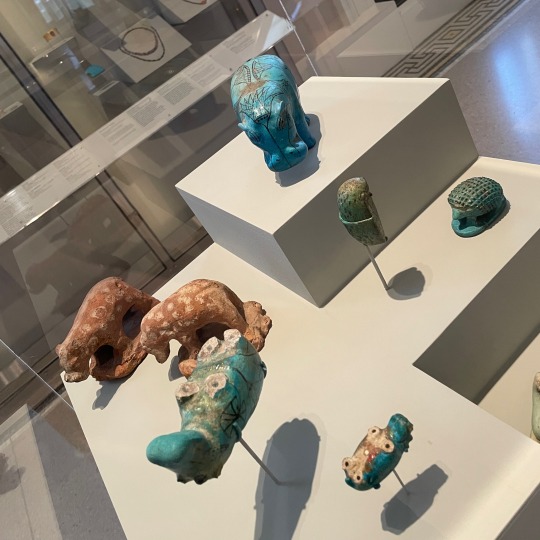
Ancient Egyptian hippo & hedgehog squad at the Brooklyn Museum!
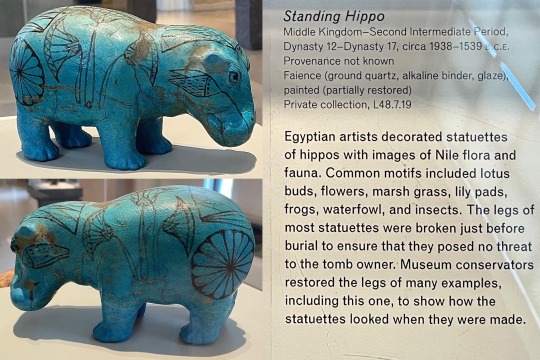
Standing Hippo
Middle Kingdom 2nd Int. Per. Dyn.12-17 c1938-1539BCE
Faience
“Egyptian artists decorated statuettes of hippos with images of Nile flora & fauna. Common motifs included lotus buds, flowers, marsh grass, lily pads, frogs, waterfowl, & insects. The legs of most statuettes were broken just before burial to ensure that they posed no threat to the tomb owner. Museum conservators restored the legs of many examples, including this one, to show how the statuettes looked when they were made.”
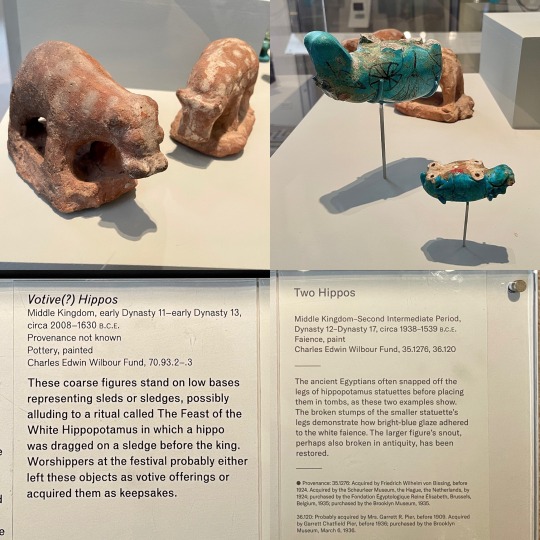
L: Votive(?) Hippos
Middle Kingdom Dyn.11-13 c2008-1630BCE
Painted pottery
“These coarse figures stand on low bases representing sleds or sledges, possibly alluding to a ritual called The Feast of the White Hippo in which a hippo was dragged on a sledge before the king. Worshippers at the festival probably either left these objects as votive offerings or acquired them as keepsakes.”
R: Two Hippos
Middle Kingdom Dyn.12-17 c1938-1539BCE
“The ancient Egyptians often snapped off the legs of hippopotamus statuettes before placing them in tombs, as these two examples show. The broken stumps of the smaller statuette's legs demonstrate how bright-blue glaze adhered to the white faience. The larger figure's snout, perhaps also broken in antiquity, has been restored.”
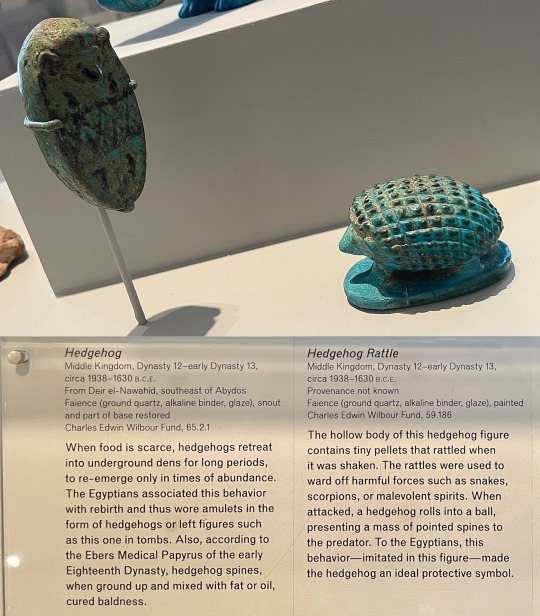
L. Hedgehog Rattle
Middle Kingdom Dyn. 12-13 c1938-1630BCE
Faience, 7.6 x 4.4 x 3.5 cm
“The hollow body of this hedgehog figure contains tiny pellets that rattled when it was shaken. The rattles were used to ward off harmful forces such as snakes, scorpions, or malevolent spirits. When attacked, a hedgehog rolls into a ball, presenting a mass of pointed spines to the predator. To the Egyptians, this behavior-_imitated in this figure-made the hedgehog an ideal protective symbol.”
R. Hedgehog Figurine
Middle Kingdom Dyn. 12-13 c1938-1630BCE
Faience, 4.2 x 4.1 x 7.1 cm
“When food is scarce, hedgehogs retreat into underground dens for long periods, to re-emerge only in times of abundance.
The Egyptians associated this behavior with rebirth and thus wore amulets in the form of hedgehogs or left figures such as this one in tombs. Also, according to the Ebers Medical Papyrus of the early Eighteenth Dynasty, hedgehog spines, when ground up and mixed with fat or oil, cured baldness.”
(note: labels are reversed - rattle is on L & figurine on R)
#animals in art#ancient art#Egyptian art#Ancient Egyptian art#Ancient Egypt#Brooklyn Museum#museum visit#hippo#hippos#hippopotamus#hippopotamuses#hedgehog#hedgehogs#pair#ceramics#pottery#faience#funerary art#votive#figurine#rattle
299 notes
·
View notes
Text
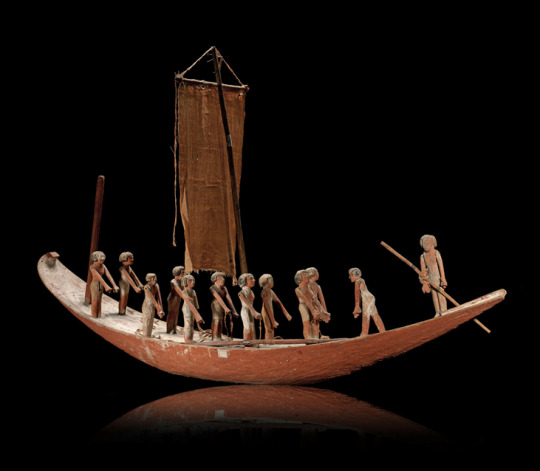
A large Egyptian gesso-painted wood model boat. Middle Kingdom, circa 2133-1797 B.C.
The sailing boat manned by ten sailors arranged in two parallel rows, with a further crew member facing forward and helmsman in the curved stern with a rudder, with a linen sail, the hull painted red, 130cm long. Boats were an integral part of everyday Egyptian life and mythology and as such were considered necessary for the afterlife. Two model boats were usually provided for each tomb, one showing the crew sailing south with the prevailing wind and the other the crew rowing north to allow the deceased to see the whole world of Egypt in both directions, but it also stands for the life and afterlife.. Both papyrus and wooden boats were recreated as models and represent the diversity of Egyptian boats.
#naval artifacts#naval history#egyptian wooden boat model#afterlife - daily life#2133-1797 B.C.#ancient seafaring
144 notes
·
View notes
Text
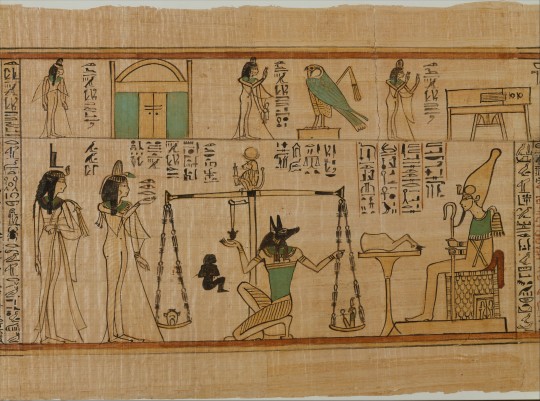
Book of the Dead for the Chantress of Amun Nauny
Metropolitan Museum of Art, Egyptian Art Collection
On view at The Met Fifth Avenue in Gallery 126
Period: Third Intermediate Period
Dynasty: Dynasty 21
Date: ca. 1050 B.C.
Geography: From Egypt, Upper Egypt, Thebes, Deir el-Bahri, Tomb of Meritamun (TT 358, MMA 65), burial of Nauny, first corridor, inside Osiris figure, MMA excavations, 1928–29
Medium: Papyrus, paint
Dimensions: L. 521.5 cm (206 5/16 in); H. 35 cm (13 3/4 in)
Accession Number: 30.3.31
7 notes
·
View notes
Text
Almost everyone has seen this image of the Seated Scribe. Located on the upper floor of the Department of Egyptian Antiquities, this is the most famous of unknown figures. We know nothing about the person portrayed: neither his name, nor title, nor even the exact period during which he lived. Nevertheless, this statue never fails to impress visitors discovering it for the first time.
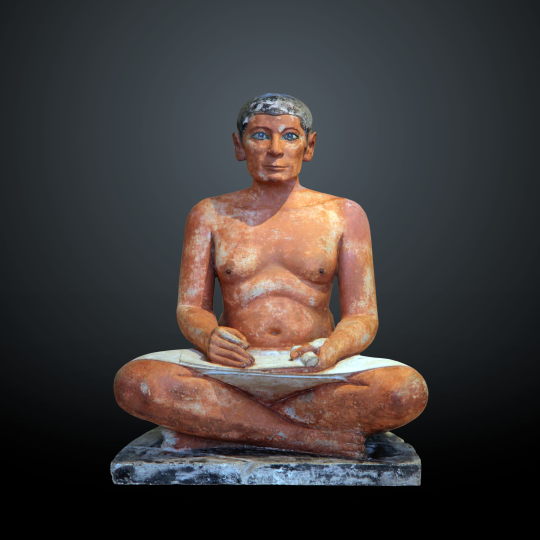
A specific posture
The Louvre's scribe, known as the "Seated Scribe", is indeed sitting cross-legged, his right leg crossed in front of his left. The white kilt, stretched over his knees, serves as a support. He is holding a partially rolled papyrus scroll in his left hand. His right hand must have held a brush, now missing. The most striking aspect of this sculpture is the face, particularly the elaborately inlaid eyes: they consist of a piece of red-veined white magnesite, in which a piece of slightly truncated rock crystal was placed. The front part of the crystal was carefully polished. The back side was covered with a layer of organic material, creating the color of the iris and also probably serving as an adhesive. The entire eye was then held in the socket by two large copper clips welded on the back. A line of black paint defines the eyebrows. The hands, fingers, and fingernails are sculpted with a remarkable delicacy. His chest is broad and the nipples are marked by two wooden dowels. The statue was cleaned in 1998, although the process merely reduced the wax overpainting. This restoration brought out the well-conserved ancient polychromy.
An unknown figure
The semicircular base on which the figure sits must have originally fit into a larger base that carried his name and titles, such as the base for the statue of Prince Setka, exhibited in room 22 of the Louvre. This base is missing, and the context of the discovery does not provide any additional information. According to the archeologist Auguste Mariette, who found the work, the statue of the scribe was apparently discovered in Saqqara on 19 November 1850, to the north of the Serapeum's line of sphinxes. But the precise location is not known; unfortunately, the documents concerning these excavations were published posthumously, the excavation journals had been lost, and the archives were scattered between France and Egypt. Furthermore, the site had been pillaged and ransacked, and no information concerning the figure's identity could be provided. Some historians have tried to link it to one of the owners of the statues discovered at the same time. The most convincing of these associates the scribe to Pehernefer. Certain stylistic criteria, such as the thin lips, which was unusual, the form of the torso, and the broad chest could support this theory. The statue of Pehernefer dates from the 4th Dynasty. This is an additional argument in favor of an earlier dating for this statue, which has sometimes been dated to the 6th Dynasty. Another argument supporting this date is that "writing" scribes were mostly created in the 4th and early 5th Dynasties; after this period, most scribes were portrayed in "reading" poses.
A scribe at work
The scribe is portrayed at work, which is unusual in Egyptian statuary. Although no king was ever portrayed in this pose, it seems that it was originally used for members of the royal family, such as the king's sons or grandsons, as was the case for the sons of Didufri (4th Dynasty), who were represented in this position.
#studyblr#history#art history#sculpture#ancient egyptian art#old kingdom#4th dynasty#5th dynasty#6th dynasty#egypt#ancient egypt#giza governorate#saqqara#auguste mariette#pehernefer#the seated scribe#limestone#papyrus
7 notes
·
View notes
Text

A mask of a female mummy dating from the Roman Period (1–200 CE). Crafted from cartonnage—a material made from linen or papyrus soaked in plaster and painted—the mask measures approximately 49 cm in height, 35 cm in width, and 15 cm in depth. Its front is adorned with a laurel-leaf diadem, symbolizing prosperity and eternal fame in Roman tradition.
Now in the Egyptian Museum of Turin. Cat. 2261
51 notes
·
View notes
Text
Legacy Chalenge The Sims 4 The Lost Era (I might make a base game version later)
Overview This Legacy Challenge invites you on a fascinating journey through ten generations of human history. Each generation represents a different period, with its own unique story, rules, and goals. The ultimate goal is to create a comprehensive story that unites all historical periods into one family legacy.
General Rules
All goals for each generation must be completed before moving on to the next generation
Each character must wear their generation color
The house and furniture must match the historical period
The use of supernatural elements (wizards, vampires, aliens, etc.) is prohibited
Generations
Generation 1: Prehistoric Period (Stone Age) Color: Earthy Brown Historical Background: In prehistoric times, a small family of hunter-gatherers settled in a fertile area near a stream. They were the first in their tribe to start growing crops and domesticating animals. Through their cave paintings, they documented daily life and the changes that the tribe went through. The family leader had a mysterious dream about his descendants who would live in different eras, and decided to start a tradition of passing down family stories from generation to generation through cave paintings
:Special rules
Children's names: Children must be named after animals or natural phenomena
Must draw on the cave walls (draw in sims) at least once a day
Only food that was gathered or hunted that day is allowed
Must sleep near a fire
It is forbidden to use modern tools Aspiration: Artist Traits: Nature lover, active, creative Career: Artist
Generation 2 - Ancient Egypt Color: Gold Historical background: In 3000 BC, during the ancient Egyptian period, there lived a special family of papyrus scribes. The family lived in a modest house on the banks of the Nile, and it was believed that they were chosen by the gods to record human history. The head scribe in the family discovered an ancient script that predicted that his descendants would live in different eras throughout history. Out of a sense of mission, he decided to start In a family tradition of recording time, with each generation continuing the dynasty in a different period.
Special rules:
Children's names: Children must be named after ancient Egyptian gods
Must write papyrus (write a book in The Sims) every day
Not allowed to leave the house during the hottest hours of the day (10:00-16:00)
Must pray twice a day (morning and evening)
The house must be built in an ancient Egyptian style Ambition: Influential Traits: Smart, creative, serious Career: Writer
Generation 3: The Middle Ages Generation color: Dark red The story: In the 12th century AD, during the Middle Ages, the family settled in a fortified European castle. The period was filled with tensions between the nobility and the church, and the family found themselves in a key role as guardians of ancient knowledge. In the castle library, they collected and copied ancient manuscripts, while secretly preserving the family tradition. They developed connections with monks and scholars, who helped them preserve ancient knowledge. Behind the scenes, they ran a secret network of scribes who dedicated their lives to preserving human knowledge.
Special rules:
Children must be named after famous kings and knights
Must learn a new language every year
Must maintain contact with the local monastery
Must copy one book a month
Cannot marry someone who cannot read or write Life ambition: Intellectual Traits: Knowledgeable, mysterious, loyal Career: Librarian
Generation 4 - Renaissance Color: Olive green Historical background: In 15th century Italy, a talented family of artists became famous for their magnificent works. In their studio in Florence, they combined art, science, and ancient knowledge. They discovered the ancient family documents and recognized in them hints of time travel. In a time of cultural renewal, they decided to commemorate their family's story through intricate artwork, combining symbols from the past and hints at the future.
Special Rules:
Children's Names: Children must be named after Renaissance artists
Must create at least one piece of art a day
Must learn a new skill every week
Must host a Cultural Salon once a week
Home must include an art studio Aspiration: Renaissance Sim Traits: Creative, Scholarly, Ambitious Career: Artist
Generation 5 - The Industrial Revolution Color: Dark Gray Historical Background: In the heart of 19th-century industrial London, a family of inventors and innovators led the Industrial Revolution. In the family factory, they developed innovative machines while maintaining meticulous records of their family history. They believed that technological advancement was the key to understanding the past and the future. Amid the soot of chimneys and the bursting steam, they continued the family tradition of innovation and documentation.
Special rules:
Children's names: Children must be named after inventors and innovators from the Industrial Revolution
Must invent or improve a machine every week
Must work at least 12 hours a day
Must live near the family factory
The home must include an invention workshop Aspiration: Successful entrepreneur Traits: Smart, ambitious, engineer Career: Scientist
Generation 6 - 1920s Color: Black Historical Background: In the vibrant New York of the 1920s, a family of businessmen and entertainers lived a life of luxury. In their family nightclub, jazz mingled with stories of the past. They kept family documents in a special safe, believing that entertainment and art were a way to perpetuate history. In a time of economic and cultural prosperity, they made their family story part of the show.
Special Rules:
Children's Names: Children must be named after jazz stars and film actors of the period
Must perform at a club every night
Must host a cocktail party once a week
Must learn to play an instrument
The house must include a private nightclub Aspiration: Famous star Traits: Charismatic, musical, sociable Career: Musician
Generation 7 - The Computer Age Color: Blue Historical Background: In the Silicon Valley of the 1980s and 1990s, a pioneering family of programmers developed groundbreaking software. In their home computer lab, they digitized all of the ancient family documents. They believed that technology was the key to preserving the past and building the future. In a time of digital revolution, they created a comprehensive family database.
Special rules:
Children's names: Children must be named after pioneers of the computing revolution
Must program at least 8 hours a day
Must upgrade home computer every month
Must attend technology conferences
Home must include a server room Aspiration: Technology expert Traits: Geek, smart, creative Career: Computer technician
Generation 8 - Present (2010-2025) Color: Turquoise Historical background: In today's global world, a family of social entrepreneurs combines technology with activism. From their eco-friendly home office, they run social projects and document family history on social media. They believe that the past and the future are inextricably linked, and strive to create a better world for generations to come.
Special rules:
Children's names: Children must be named after social leaders and environmental activists
Must maintain a daily blog
Must participate in volunteer activities once a week
Must live a green lifestyle
The house must be eco-friendly
Aspiration: Green Leader Traits: Activist, sociable, nature lover Career: Social entrepreneur
Generation 9 - Near Future (2040-2100) Color: Yellow Historical background: In a mid-21st century smart city, a family of scientists and researchers leads research in the field of sustainability and clean technologies. In their advanced family laboratory, they combine their family's ancient knowledge with futuristic technologies. They believe that the key to saving the planet lies in understanding the past and planning wisely for the future.
Special rules:
Children's names: Children must be named after pioneers of green technologies
Must develop a new green technology every month
Food must be grown on a hydroponic farm
Must use only renewable energy
The house must be designed in a futuristic and green style Aspiration: Revolutionary scientist Traits: Innovator, nature lover, smart Career: Scientist
Generation 10 - The distant future (2100-2150) Color: White Historical background: In a sustainable community of the mid-22nd century, the last generation of the family unites all the knowledge and traditions accumulated over the generations. In their unique house, which combines elements from all historical periods, they create a living museum of family heritage. They believe that it is time to reveal their amazing family story to the whole world.
Special Rules:
Children's Names: Children must be named with meaningful names from all previous generations
Must incorporate one element from each previous generation into daily life
Must document and preserve family history
Must teach future generations about family heritage
The home must include a family museum displaying items from all generations Aspiration: Storyteller Traits: Smart, Creative, Traditional Career: Historian
3 notes
·
View notes
Photo
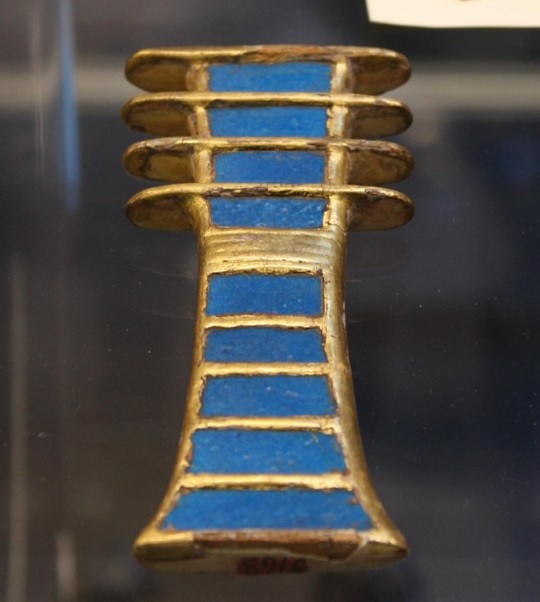
Djed
The Djed is an ancient Egyptian symbol for stability which features prominently in Egyptian art and architecture throughout the country's history. `Stability' should be understood to mean not only a firm footing but immutability and permanance. The symbol is a column with a broad base which narrows as it rises to a capital and is crossed by four parallel lines. The column and the lines are sometimes brightly painted and other times monochrome. The djed first appears in the Predynastic Period in Egypt (c. 6000-3150 BCE) and continues through the Ptolemaic Dynasty (323-30 BCE), the last dynasty to rule Egypt before it became a province of the Roman Empire.
The djed is often overlooked in Egyptian art, and especially in architecture, simply because it is so ubiquitous; the djed is featured on pillars, tomb walls, architraves (the main beam which rests on pillars), palace walls, sheets of painted papyrus, and especially sarcophagi. Once one is aware of the djed and its importance to ancient Egyptian culture it is impossible to miss. It is a potent symbol associated with the god Osiris and his return from the dead. The symbol has been interpreted to represent different objects such as the god Osiris' backbone, the tamarisk tree which enclosed the god, four pillars rising one behind another, and a fertility pole raised at festivals. `Stability', however, seems to have been its prime meaning and the one which the ancient Egyptians attached the greatest importance to.
Meaning & Origins
The precise origin of the djed is unknown but it was associated with the god Ptah, an early creator god in the Predynastic Period whose attributes were later assumed by the deities Atum and Osiris. According to historian Clare Gibson, the djed was an early phonogram which could also act as a pictogram or ideogram. A phonogram is a symbol representing a sound and a pictogram a symbol for a specific word or phrase while an ideogram is a symbol of a thing itself without reference to words or sounds (such as numerals where one recognizes the symbol 10 as representing a certain quantity). The djed symbolized the spoken word-concept for stability, was the written word for stability, and stood for the concept itself.
In the Predynastic Period it may have originally been a representation of a fertility pole upon which sheaves of grain were suspended at festivals. This pole may have been a feature of early fertility rituals which eventually came to be associated with the god who made the land fertile. The god Ptah carried a sceptre which combined the djed and the Ankh (symbol of life) and is referenced as "The Noble Djed" in ancient inscriptions. The Djed Pillar Festival was held annually at which an actual djed pillar was built and raised by the local priesthood on the first day of the harvest season. Raising the pillar may have originally symbolized the grains rising from the earth but, in time, came to represent the god Osiris returning from the dead.
With the rise of the cult of Osiris, the djed came to be firmly associated with him and, especially, with the tree of Byblos which enclosed him and the pillar made from that tree. The djed also symbolized the backbone of Osiris in that, just as Osiris rose from the dead, the deceased would rise from their body after death. In the same way that the human backbone allowed one to sit up and stand and walk, the spiritual image of Osiris' backbone would encourage the soul to rise up from the body and move toward the afterlife. The myth of Osiris was one of the most popular in ancient Egypt, especially in the period of the New Kingdom (1570-1069 BCE). The story details the death of the god, his ressurection by his wife Isis, and descent to the underworld to reign as Lord of the Dead.
Continue reading...
88 notes
·
View notes